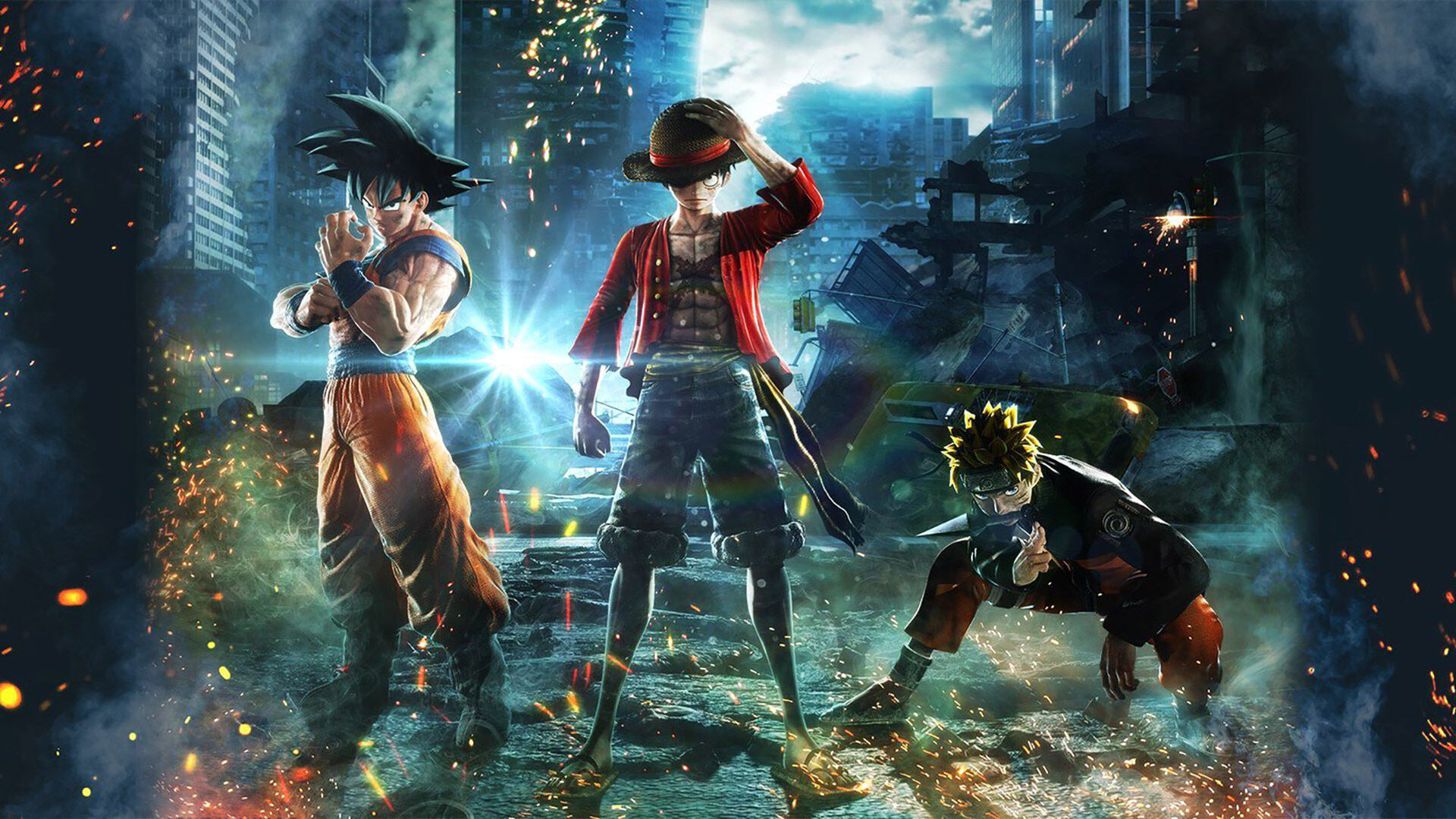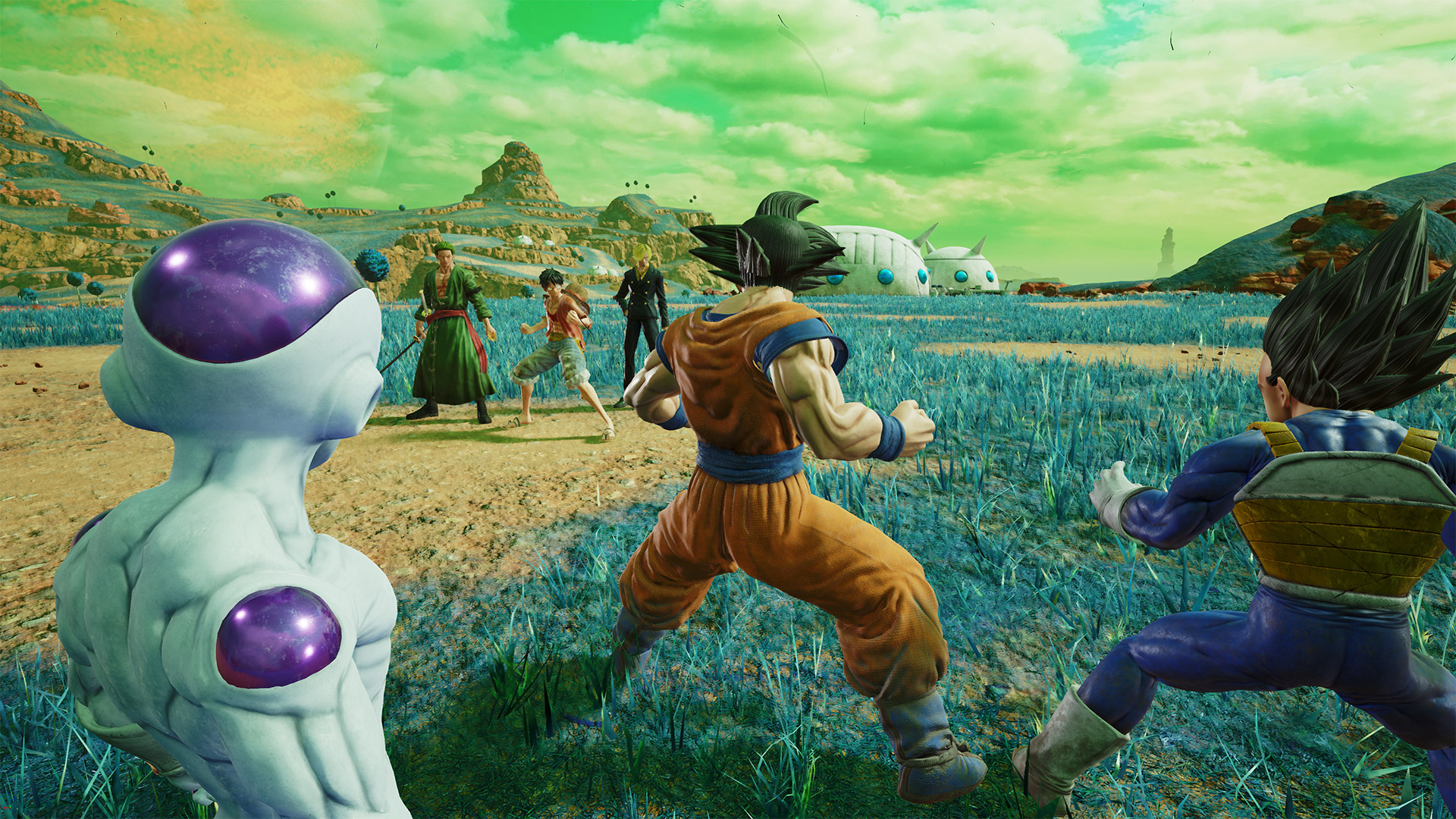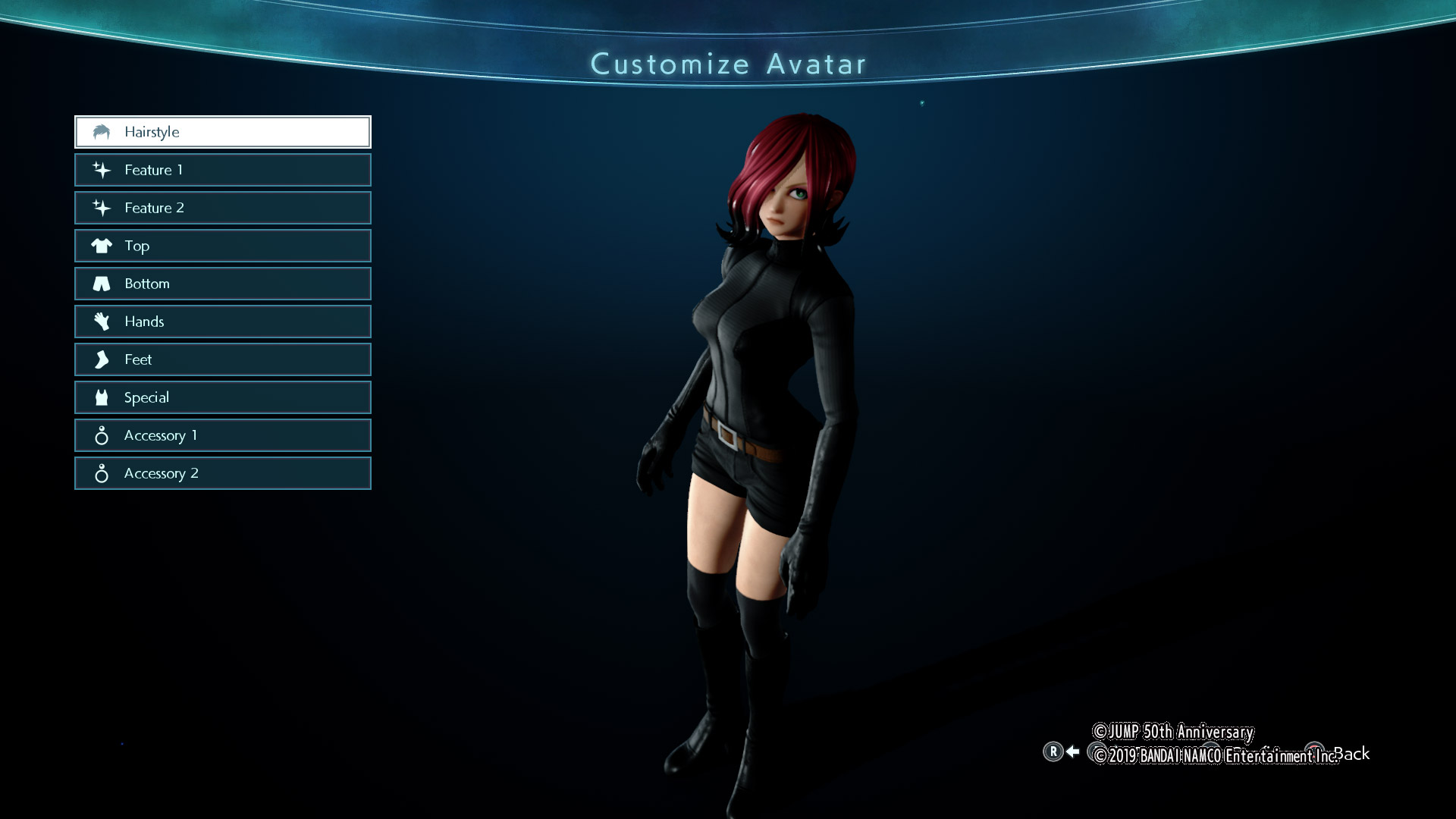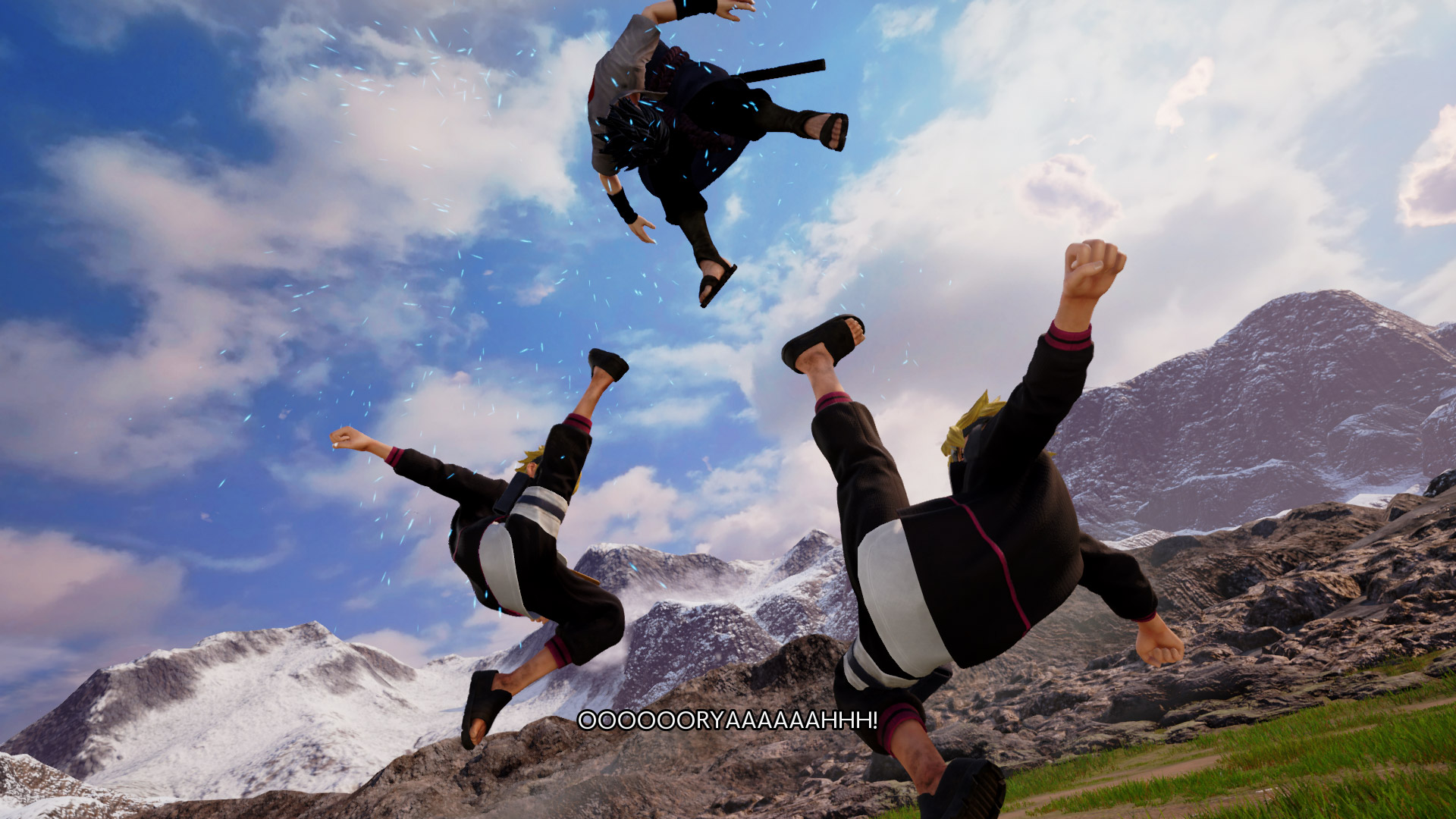Jump Force Review
New York’s Times Square sits in near ruin, as buildings crumble and explosions burst below the crimson sky. High above, Frieza smiles as he and an army of red-eyed soldiers descend to lay waste to the city. Suddenly, a hero appears: Goku, who flies up to trade blows with his fearsome foe. When Goku dodges one of Frieza’s energy attacks, the beam continues on its path until it strikes down a regular human being. Specifically, me. As the legendary warrior reels in horror at seeing what’s happened, his ally Trunks rushes to my side, informing me that there’s only one thing that can save my life now. Trunks shoves a glowing cube into my body, which, along with saving me from death, also turns me into a hero.
If that seems like a rather abrupt and not-well-thought-out way to start a review, it’s also not the best way to start a game either. And yet, that is exactly how Jump Force kicks off, tossing players into a situation that really isn’t concerned with trivial things like setup or exposition. Typically, when a piece of entertainment starts in such a way, it’s to serve one of three goals: creating a mysterious occurrence where someone will try to figure out how or why it happened; being the first piece of a non-linear selection of scenes a la movies such as Pulp Fiction; or getting world building out of the way and admitting the “how” and “why” aren’t important, such as in zombie-based fiction. Are any of those the reason Jump Force starts the way it does? I dunno.
I give that answer because “I dunno” seems to be the mantra of this game. Why was it important that I, a seemingly random human being, survive? I dunno. What led up to the Earth being attacked? I dunno. How did Goku, Luffy, and Naruto end up meeting each other in the first place? Am I really supposed to assume that all of these beings I’m meeting are actually comic characters come to life? Why do the other members of the various franchises that appear in Jump Force never seem fazed one bit when recruited by a team of fighters from completely different fake universes? Who built the place where all of these beings converge to form the J-force, and did it exist before the recent outbreak of planetary attacks? I dunno. Eventually, the story does bring at least some answers, but they only came long after I’d gotten tired waiting for their arrival.
And, oh yeah, one other thing: Who are all of these people? Yes, most players venturing into Jump Force will undoubtedly be anime fans to varying degrees, but the game has no patience for those who don’t have full working knowledge of the full 50-year run of Japan’s weekly manga anthology Shonen Jump—where beloved series like Dragon Ball Z, One Piece, and Naruto were all born—has existed. Even as someone who doesn’t actively follow anime anymore, it’s hard not to know that Naruto had the gall to name his child Boruto, and the old-school fan in me loves seeing inclusions like City Hunter’s Ryo Saeba, but I’ll be damned if I know who Kaguya Otsutsuki or Sosuke Aizen or Gon Freecss or Killua Zoldyck are. Jump Force spends zero time introducing you to these characters, what worlds they come from, or what impact they could have on the story. Hell, it doesn’t even have any sort of in-game encyclopedia where you can learn about the various fighters and the franchise they come from, which seems like it would have been a great thing to have in a game released during Shonen Jump’s 50-year celebration.
Instead of taking the time to properly introduce and integrate the cast, players recruit new members to the team through selectable missions that consist of maybe 30 seconds of cutscenes and then a one-round fight. It’s par for the course in Jump Force, however, as the game seems to lack any sort of drive to create a complete, fulfilling narrative experience. When the game begins proper, you’re dropped into J-Force HQ and told to save the world. How do I do that, though? Where am I supposed to go? None of that was evident from the start, and even poking my nose around the various corners of the base turned up nothing at first. Everything in the game is quest-based, even the overarching story, but it isn’t always clear how to unlock the next “key” missions you’ll need to complete to keep the game rolling along. Jump Force is structured as one big lobby where you and other players can run around together minimally interacting between fights, but similar other games usually run players through a set amount of required progression first in order to get them fully versed in what to do once things open up more. Yet again, though, ain’t nobody got time for that.
And, oh yes, the jank. By now you’ve no doubt seen examples of Jump Force’s overall feeling of utter cheapness, and it’s all true. Character animations are half-assed both in and out of fights, cutscenes at times have unbelievably bad mouth flapping and character positioning, polish is missing from nearly every element of the game, and I’ve had numerous connection issues with the game’s servers, which—no matter what I was in the middle of doing—kicked me all of the way out to the main menu. There’s also that art style, man. I’ve seen some people say they actually like the game’s more “mature” visual style, but for a project centered around classic anime and manga franchises, it just feels heretical to remake everything with such generic, uninspired designs. Some characters, like Fist of the North Star’s Kenshiro, turn out mostly fine in the process, while others, such as the aforementioned Gon, are downright terrifying.
However, along the way, something happened: I started to like Jump Force in part because of how terrible it is. At first, I was furious at the game for being such a shameless waste of my time (and many players’ money), but then it legitimately reached “so bad it’s good” territory. The stupid way my character ran and jumped around J-Force HQ because weirdly charming; every time a cinematic was simply okay, I was disappointed knowing it could have been oh so much worse (in a good way). Everything I’ve said about the game still stands, and both Bandai Namco and Spike Chunsoft should be ashamed of this effort, because both can do better. Just because it’s a bad game, however, doesn’t mean it isn’t an enjoyable one—at least if you can learn to either forgive or cherish some of its flaws.
One of the things that lead to that turnaround is that Jump Force isn’t as bad in the one area that matters most: as a fighting game. Structured similarly to other arena-based fighters such as the Naruto Shippuden series, battles play out between two teams of three characters as players run around in 3D environments unleashing both short- and long-range attacks in an attempt to get the upper hand. Players throw normal punches and kicks through a two-button system—basically light and heavy hits—and each will produce an auto combo if mashed enough times in a row. Special moves are then called forth (if you’ve got enough meter) by holding the right trigger and hitting one of the four face buttons, with the usual assortment of other options such as throws, blocks, dodges, jumps, tagging teammates in and out, or sending your character into a more powerful “Awakened” state all also available.
Gameplay isn’t nearly as good as what CyberConnect 2 or other competitors have brought us over the years, and I’ve got a few legit frustrations with things like the shallowness of the game’s combo system and what feels like really wonky attack priorities at times. Still, I’ve had legitimate fun with Jump Force when pushing the story aside and focusing on the fighting. I’ve been iffy on the balance in some previous arena fighters—especially in those where projectiles were just too damned overpowered—but that was rarely the case here. Fights can turn into a real game of cat-and-mouse where brains can win out over brawn, and I have to give Jump Force credit for how much it does do with so little. I mean, I wish every element of combat was deeper—because they absolutely could have been—but beating up anime celebrities over and over never really got old.
That might not be the case if I wasn’t doing so as my own custom character—which is ironic considering that was one of the features I thought sounded dumb going into Jump Force. To me, it seemed counterproductive to bring together a roster of legendary heroes and villains, only to then ask the player to make and control their own random schmuck. And yet, that option for a bit of self-insertion actually lead to me caring more about what was going on. Watching my ridiculous original anime character (do not steal) using Kenshiro’s Hundred Rending Fists against Zoro or punching Goku in the gut multiple times with the Delaware Detroit Smash from My Hero Academia made me smile way more than I was expecting. I’ve always been a sucker for custom characters, so working to build mine up both in terms of skill and wardrobe kept me motivated even in the moments when the story was hot trash. (But, come on—why can’t I preview new outfit items before I plunk down the huge amounts of gold some of them require? And why do you have to be so stingy with edit pieces?)
Jump Force’s custom heroes do lead into one final element to the game that totally puzzled me. As I said previously, fights are 3-vs-3, but in a completely odd twist, every member of your team shares the exact same health bar. While there can be strategic reasons to swap out one fighter for another, such as wanting to mix things up and keep your opponent on their toes, much of the time I found that I got along just fine having my gal Jun just solo every single encounter. The story will throw various fight balances at you—sometimes 2-vs-3, sometimes 1-vs-2, sometimes 1-vs-3, and more—but it never makes any difference in terms of difficulty. With only ever having to worry about knocking one health bar down to zero, it could be me versus the entire Jump Force roster for all I care, as I’d still have the same odds. Having the various Shonen Jump stars as teammates gives bonuses even if you never swap to them, as each can offer passive support or jump in for a quick assist, but it’s weird to me that the game put in so little effort to encourage players to have a strong, well-balanced team in the way something like The King of Fighters does.
Jump Force is a lazy, sloppy, uninspired mess of a game—but as much as I want to, I can’t hate it. It’s an experience I would only grudgingly recommend to anime fans, be totally non-committal on for fighting game fans, and recommend those who fall into neither camp stay away from. And yet, in my time at EGM, there are games I’ve given higher scores that I’d probably want to return to less than this. Jump Force asks a lot from players in forgiving its flaws that get in the way of the fun, but if you can laugh at its failings and not ask too much from its fights, jumping into the ring with friends or strangers and then beating them to a pulp with your cobbled-together protagonist and a few of their anime pals can offer some honest hours of fun.
So, in the end, am I recommending that you give Jump Force a chance despite its numerous failings? I dunno.
Jump Force
Summary: Jump Force is the kind of game that would usually just come and go due to how unimpressive and flawed of an effort it is, and it’s more than likely that that’s exactly what it is going to do. And yet, buried beneath all of the bad is some honest amount of good. It’s almost a shame that Jump Force wasn’t more of a mess in everything other than its 3-vs-3 fights, because the game would be a whole lot more enjoyable if we were able to laugh at its terribleness more often.
Score: -
Jump Force was reviewed using review code, physical copies, or hardware provided by Bandai Namco. Scores are graded on a scale of E (Bad) to S (Special) in homage to Japanese video game grading scales, with the understanding that an S still does not denote a "perfect" score. Scores may have been adjusted from the original source to better fit my personal scale.




